Madhava Nidana Chapter 56 Mukha Roga Nidanam
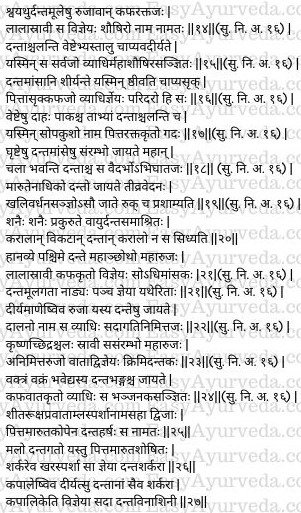
This article explains Madava nidana 56th chapter “Mukha Roga Nidanam”. Causes, pathology and symptoms of Mukha Roga are explained in this chapter. Mukha Roga means diseases of mouth.
Table of Contents
Mukharoga Samanya Hetu
General Etiological Factors of ‘Diseases of the Mouth’
Due to excessive indulgence in the foods prepared with meat of animals and birds of aquatic regions, milk, curds and fish, the doshas with the predominance of kapha would undergo abnormal increase and produce diseases of the mouth. (1)
Read – Diseases Of Lips (Oshtagata Rogas) – Types, Symptoms Treatment
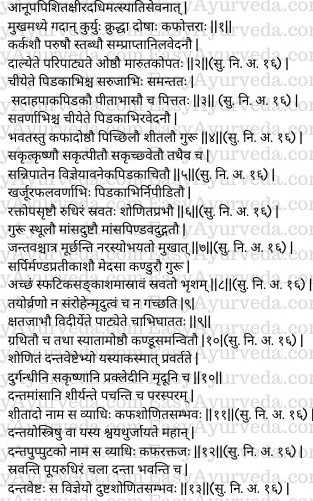
Vataja Oshta Roga
When vata gets increased in the lips, the lips become rough, hard, and immobile. There would be pain of vata nature (vata type of pain). Cracks and fissures appear on the lips. (2)
Pittaja Oshta Roga
In the disease of the lips caused by increase of pitta (in the lips), the lips are covered with painful papules along with burning sensation and suppuration. There is yellowish discoloration of the lips. (3)
Kaphaja Oshta Roga
When kapha gets abnormally increased in the lips, papules having colour of the skin (no discolouration) and are devoid of pain (slightly painful) develop on the lips. The lips are sticky, cold and heavy. (4)
Sannipataja Osta Roga
In the disease of the lips caused by simultaneous aggravation of all the three doshas the lips sometimes appear black, sometimes yellow and white at other times. Many types of pidakas (papules) will also appear on the lips. (5)
Raktaja Oshta Rog
When the lips are affected by vitiated blood, papules resembling the fruits of date-palm (Phoenix sylvestris) in appearance, which discharge blood and are red in colour, develop on the lips. (6)
Mamsaja Oshta Rog
When the lips are contaminated by the muscles, they become heavy and thick and raised like lumps of muscles. Worms are formed on both sides of the mouth. (7)
Read – Granthi: Cystic Swelling, Types, Features, Ayurvedic Treatment
Medoja Oshta Roga
If the lips are contaminated by vitiated medas (fat), the lips appear like the fluid portion of the ghee, develop itching and heaviness, discharges fluids which are clear like spatika and are colourless in large quantities. The ulcers formed from this neither heal easily nor become soft. (8)
Abhighataja Oshta Roga
When the disease of the lips has occurred due to the injury (to the lips), the lips will be cut and become reddish as occurs in case of injury. They are cut or torn, will have lumps and will have itching. (9)
Read – Itching And Pruritus: Ayurvedic Understanding
Diseases of the gums
Dantamulagata Rogas
Sitada
The disease in which bleeding occurs suddenly from the gums without any reason, the gums become foul smelling, black, wet (with discharges) and smooth, the muscles tear off (detach) and start suppurating each other, and is produced by abnormal increase of kapha and rakta (blood) is known as Sitada. (10-11)
Dantapupputaka
When severe swelling occurs in the gums surrounding two or three gums, caused by abnormal increase of kapha and blood together is known by the name dantapupputaka. (12)
Dantavesta
The disease in which pus and blood (pus mixed blood) is discharged from the gums and the teeth begin to shake is known as dantavesta. This condition is caused by bad (contaminated) blood. (13)
Read – Danta Veshta – Causes, Symptoms, Treatment, Modern Correlation

Saushira
A swelling which occurs at the root of the tooth caused by increased kapha and blood together is painful and causes free flow of saliva is known as sausira.
Mahasausira
When in sausira (above explained condition), the teeth start getting loose from the gums and shaking, fissures occur in the palate (apart from the other symptoms of sausira), which is known as Mahasausira. This condition is caused by simultaneous increase of all the three doshas (together). (15)
Paridara
The disease in which the gums undergo decomposition and causes frequent spitting of blood is called paridara. It is caused by an increase of pitta, blood and kapha together. (16)
Read – Gingivitis – Causes, Symptoms, Treatment, Ayurvedic Remedies
Upakusa
The disease in which there is burning sensation and suppuration in the gums and due to these the teeth become loose and shaking. This disease caused due to the abnormal increase in pitta and blood together is known by the name upakusa. (17)
Vaidarbha
The disease in which the gums get frayed (grazed or rubbed) develop severe swelling, pain and burning sensation and the teeth become loose and shaky is called vaidarbha. This condition is caused due to trauma. (18)
Khalivardhana
Due to the aggravation of vata an extra tooth erupts causing severe pain during its eruption. Once the extra tooth erupts, the pain subsides. This condition is known by the name khalivardhana. (19)
Read – Vardhana Gum Disorder Symptoms, Treatment
Karala
The vata located in the teeth undergoes an increase and gradually (over a period of time) makes the teeth irregular and ugly. This condition is known as Karala. It is incurable and does not respond to any treatment. (20)
Adhimamsa
The condition in which a severe swelling appears in the gums surrounding the last molar tooth, which is highly painful and causes dribbling of saliva is known as adhimamsaka. It is caused by increased kapha. (21)
Dantanadi
There are five kinds of nadis (sinus) which would manifest in the root of the teeth (gums). These are similar to those described previously (Nadivrana – sinus ulcers). (21)
Note – The five types of dantanadis are – vataja, pittaja, kaphaja, sannipataja and shalyaja.
Read – Dantanadi (Dental Sinus) Causes, Pathogenesis, Symptoms, Treatment
Diseases of the teeth
Dantagata Rogas
Dalana
A condition of the teeth in which there is severe pain in the tooth as if they are breaking open or bursting is called Dalana. It is caused by increased vata. (22)
Krimidantaka
The condition in which the tooth which has black holes in them and are shaky (loose), which have discharges, swelling and severe pain which comes on without any apparent cause and caused by vitiated vata is called as krimidanta / krimidantaka. (23)
Read – Ayurvedic Remedies, Treatment for Dental Caries, Plaque, Tartar
Bhanjanaka
A condition, in which the face assumes an irregular shape and the teeth get broken, is caused by increased kapha and vata together is called as Bhanjanaka. (24)
Dantaharsa
A condition wherein due to the increased pitta and vata the teeth become incapable of tolerating the touch (contact of) of cold and dry foods, swift cold breeze and sour things (foods and drinks) is called by the name dantaharsa. (25)
Read – Sensitive Teeth – Causes, Symptoms, Ayurvedic Treatment
Dantasarkara
The dirt accumulated on the teeth gets dried up by the action of increased vata and pitta (together). This dried up dirt becomes hard, assumes the form of gravel and accumulates on the teeth. This condition is called as Dantasarkara. (26)
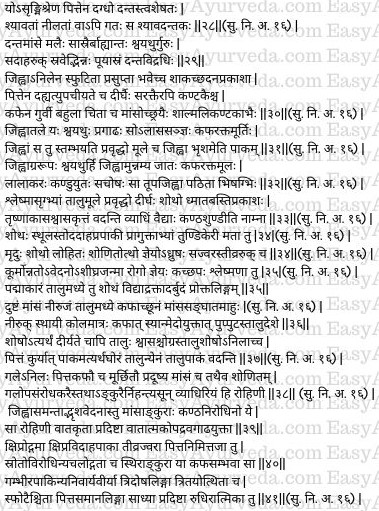
Kapalika
Kapalika is a more complicated version of dantasarkara (discussed above). Here the pieces of teeth along with solidified and accumulated hard dirt (as in sarkara) on them, which appear like pieces of earthen vessel (big flakes of accretions) peel off along with parts of the tooth, and finally destroy the teeth. This condition is known as Kapalika. (27)
Syavadantaka
A condition in which the tooth becomes black of blue in colour, being burnt by the increased pitta combined with the vitiated blood is known as syavadantaka. (28)
Danta Vidradhi
A severe (big) swelling occurs inside and outside the gums caused by the vitiated blood and all the three increased doshas. It is associated with burning sensation and pain. On bursting open it discharges pus mixed with blood. This is called as Danta Vidradhi. (29)
Diseases of the tongue
Jihvagata Rogas
Jihvakantaka
Vataja Jihvakantaka – When increased vata affects the tongue it would become fissured, numb (loss of sensation) – loss of taste perception, and would resemble a leaf of a tree (rough, coarse).
Pittaja Jihvakantaka – When increased pitta affects the tongue there would be burning sensation in the tongue. The tongue would become studded with red coloured long thorny projections.
Kaphaja Jihvakantaka – When increased kapha affects the tongue, the tongue would become heavy, thick, and will be studded with muscular sprouts resembling those of Shalmali tree (Bombax malabaricum). (30)
Alasa
A condition in which a profound swelling occurs beneath the tongue caused by combined aggravation of kapha and rakta (blood) is called Alasa. This swelling would increase in size and cause stiffness (incapable of movement) of the tongue and also would cause severe suppuration at the root of the tongue. (31)
Upajihvika
A condition in which a severe swelling caused by increased kapha and blood together, having the appearance of the tip of the tongue, is formed beneath the tongue and lifts up the tongue. This disease is called as upajihvika. This is associated with excessive salivation, itching and burning as if the tongue is in direct contact with the fire. (32)
Read – Ranula (Upajihwika) Oral Disorder – Symptoms, Ayurvedic Treatment
Diseases of the palate
Talugata Rogas
Kantasundi
An elongated swelling resembling a bag inflated with air gets manifested at the root of the palate, caused by kapha and blood getting increased together, associated with thirst, cough and dyspnoea (breathing difficulty). This disease of the palate is called by the name Kanthasundi. (33)
Tundikeri
The swelling which is caused by kapha and blood just like the condition explained above (kanthasundi) will be known as Tundikeri if it becomes thicker and is associated with pricking pain, burning sensation and suppuration. (34)
Read – Tonsillitis Ayurvedic Treatment, Herbs, Home Remedies
Adhrusa
A condition, in which a soft, red swelling is caused by increased blood, is accompanied with fever and severe pain is known by the name adhrusa. (34)
Kacchapa
Kachchapa manifests in the form of a rounded big swelling resembling the upper surface of the shell of a tortoise. This condition is painless and develops slowly and is caused by increased kapha. (35)
Talvarbuda
It is a swelling which resembles a lotus flower and manifests at the center of the palate and has symptoms similar to that of raktarbuda.
Mamsa sanghata
It is a similar swelling (same as talvarbuda) manifesting at the centre of the palate involving mamsa – contaminated muscle tissue (it is a muscular swelling or lump at the centre of the palate), caused by increased kapha and is painless. (35)
Read – Diseases Due To Pathological Muscle Tissue – Mamsa Pradoshaja Rogas
Talupupputa
A swelling (papule) of the size of a jujube fruit (Ziziphus jujuba) which is painless, fixed (immobile), caused by combination of abnormally increased kapha and medas (fat) together, developing in the palate is called by the name talupupputa.
Talusosa
Excessive dryness and fissures occurring in the palate, caused by aggravated vata and associated with severe dyspnoea (difficulty in breathing) is known as Talusosa.
Talupaka
Pitta aggravated in the palate causes severe and dreadful suppuration (in the palate). This is known as Talupaka. (36-37)
Read – Kantagata Rogas Diseases Of The Throat
Galagata Rogas
Galagata rogas mean diseases of the throat:
Rohini
Rohini and its types, symptoms
Vata, pitta and kapha getting increased in the throat (either individually or all together) would invade mamsa (muscle) and rakta (blood) and produce sprouts inside the throat subsequently causing obstruction of the throat passage and death. This disease is called Rohini.
Vataja Rohini – In vata predominant rohini there will be severe pain all over the tongue, muscular sprouts which cause obstruction to the throat, and severe complications (and other symptoms) of vata increase.
Pittaja Rohini – In pitta predominant rohini, there is quick appearance of sprouts, burning sensation and suppuration, and is associated with high fever.
Kaphaja Rohini – In kapha predominant rohini, the sprouts are immobile, big in size and fixed. They cause total obstruction of the throat.
Sannipataja Rohini – In Rohini caused by simultaneous aggravation of all the three doshas, suppuration occurs in the deeper tissues. It will not respond to any treatment (is incurable) and presents with symptoms of aggravation of all the three doshas.
Raktaja Rohini – In rohini caused by abnormally increased blood, there will be widespread red papules and will present with symptoms of pitta increase. This condition is curable. (39-41)
Read – Rohini Causes, Symptoms, Prognosis, Types, Treatment
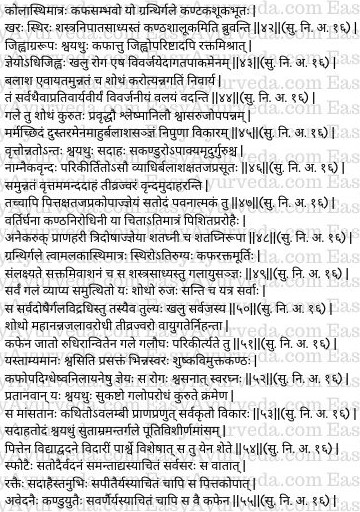
Kanthasaluka
A cystic swelling (tumour) of the size of seed of jujube fruit, produced by increased kapha, occurring in the throat, appearing like thorns or spikes, rough, fixed (immobile), and curable only by surgical methods is called by the name Kanthasaluka. (42)
Adhijihva
A swelling which occurs above the level of (top of) the root of the tongue, resembling the tip of the tongue, caused by kapha along with blood is known as adhijihva. If the swelling is found along with suppuration, it should be refused treatment (because it is incurable). (43)
Read – Adhijihwa Throat Disorder (Epiglottitis) Causes, Symptoms, Treatment
Valaya
Kapha undergoing abnormal increase produces large sized swelling in the throat causing obstruction to the passage of food. This condition is called by the name valaya. It is an intractable disease which doesn’t respond to any type of treatment and hence should be refused treatment. (44)
Balasa
Kapha and vata having aggravated together produces a swelling in the throat which causes difficulty in breathing and pain, which tends to destroy (damage) the marmas (vital organs or spots in the body). This disease is identified as Balasa by the experts and is difficult to treat. (45)
Ekavrnda
A swelling developing inside the throat, which is round, elevated, accompanied with burning sensation, itching, not suppurating, not too smooth (little hard) and heavy is known as Ekavrnda. This condition is caused by kapha and blood together. (46)
Vrnda
A condition in which an elevated and rounded swelling occurs in the throat being associated with severe burning sensation and high fever is called Vrnda. This is caused by combined vitiation of pitta and blood. If vata is involved in this condition there will also be pricking pain. (47)
Shataghni
A swelling obstructing the throat studded all over with multiple muscular sprouts resembling a Sataghni (a weapon in the form of an iron ball with sharp spikes), presenting with many kinds of pain and cause death is called as Sataghni. This condition is caused by simultaneous vitiation of all the three doshas together. (48)
Read – Laryngitis (Swelling of voice box) – Causes, Ayurvedic Treatment
Galayu
A cystic swelling occurring in the throat which is of the size of seed of Amalaka (Phyllanthus emblica), is immobile, very painful, and caused by combined aggravation of kapha and blood is known as Galayu. Due to this, the food remains obstructed in the throat (difficulty in swallowing the food) and can be treated by surgical methods (requires surgical treatment to cure this disease). (49)
Galavidradhi
The condition in which a swelling which involves all the areas of (entire) the throat develop, which presents with different kinds of pains caused by all the doshas, is called as galavidradhi. It is caused due to simultaneous aggravation of all the three doshas and is similar to tridoshaja vidradhi. (50)
Galaugha
A profound swelling in the throat, caused by increased kapha associated with vitiated blood, which causes obstruction to swallowing of food and water, associated with severe fever and causing the movements of vata (aeration, respiration) is called by the name Galaugha. (51)
Svaraghna
A condition in which due to the coating and subsequent obstruction of the air passages by kapha (sputum, phlegm), the patient finds difficulty in breathing along with darkness before the eyes, has broken voice, dryness of the throat and loss of movement of the throat, is known as Svaraghna. This condition is caused by vitiated vata. (52)
Read – Hoarse Voice Causes, Ayurvedic Treatment, Home Remedies
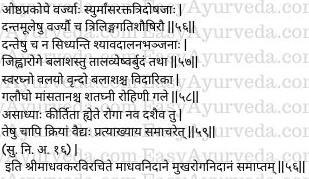
Mamsatana
A broad swelling which has spread out in the throat, which is troublesome (with severe painful symptoms) and gradually obstructs the throat by hanging down and eventually causes death is known as Mamsatana. This condition is caused by simultaneous increase of all the three doshas together. (53)
Vidari
A swelling which occurs inside the throat and in the mouth, having burning sensation and pricking pain, has coppery colour, the muscles surrounding which has foul smell and fall off getting detached, is caused by predominant vitiation of pita is called by the name vidari. This occurs in the side of the face and throat on which the patient usually sleeps. (54)
Sarvasara Roga / Mukhapaka
Vataja Sarvasara / Mukhapaka – In this condition the inside of the mouth is covered by papules (sores) having pricking pain.
Pittaja Sarvasara / Mukhapaka – In this condition the inside of the mouth is covered by papules which are red or yellow in colour, thin and have a burning sensation.
Kaphaja Sarvasara / Mukhapaka – In this condition the inside of the mouth is covered by papules which are painless, have itching and are of the same colour as that of the skin (surrounding area). (54-55)
Read – Mouth Ulcers Ayurvedic Treatment, Medicines, Remedies, Tips
Prognosis
Prognosis of Oshta kopa and other conditions
Among the diseases of the lips – ostha prakopa produced by mamsa – muscle, rakta – blood, rakta – blood and all the three doshas should be rejected and should not be treated.
Among the diseases of the gums – tridoshaja nadivrana and saushira are considered as incurable and hence should be rejected.
Among the diseases of the teeth – Syavadanta, Dalana and Bhanjanaka are incurable.
Among the diseases of the tongue – Balasha is incurable.
Among the diseases of the palate – Arbuda is incurable.
Among the diseases of the throat – Svaraghna, Valaya, vrnda, Balasha, Vidarika, Galaudha, Mamsatana, Shataghni and Rohini are considered incurable.
These nineteen diseases are incurable and the physician should consider them as unfit for treatment and reject them. (56-59)
Thus ends the chapter on Mukha Roga Nidanam in Madhava Nidana text written by Acharya Madhavakara.










